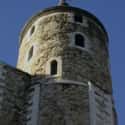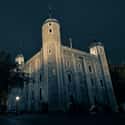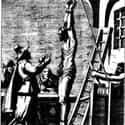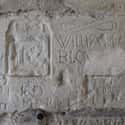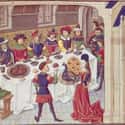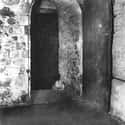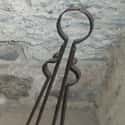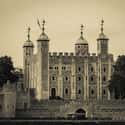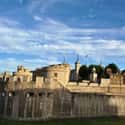-
(#1) The First Prisoner At The Tower Of London Set The Tone For A Lot Of Later Captives
The Tower of London was first used as a prison by King Henry I. After becoming king in 1100, Henry imprisoned Ranulf Flambard, the Royal Clerk who served his predecessor and brother, William Rufus, on charges of extortion and simony. Flambard was also the Bishop of Durham and, because of his flamboyant lifestyle, he was perceived as greedy and cruel.
In many ways, Flambard was a scapegoat for the unpopular policies William Rufus had implemented. Nonetheless, fhe ound himself in the Tower. Flambard was able to maintain his luxurious lifestyle while in confinement. He had an allowance, kept his servants, and ordered in the best food as he tried to maneuver his way out of prison through his political connections. None of his efforts worked so he took another approach - he planned his escape.
-
(#2) Getting Guards Drunk Was An Effective Diversion For Escape
The first prisoner, Ranulf Flambard, was allowed to bring in the best wines and hold large feasts and decided to use this to his advantage. He wined and dined his guards and used the occasion to discretely bring in a rope hidden in a wine cask.
After a long evening of food and drink, as the guards were appropriately drunk, Flambard was able to escape. According to legend, he lowered himself from the window of the Tower to associates waiting below with horses. Flambard and his accomplices fled England for Normandy where Flambard became Duke Robert's chief advisor. He later led Robert's military on an attempt to invade England but the efforts proved unsuccessful. Flambard was able to reconcile with Henry in 1101 and was restored to his former position at Durham.
When Jacobite William Maxwell was imprisoned in the Tower of London during the early 18th century, he - and his wife - used booze to distract his guards. Lady Winifred Maxwell made the trip to London from their home in Scotland to ask the king for clemency for her husband. King George refused, so when Lady Maxwell, her maid, and two others visited William the night before he was to be executed, they distracted the guards with alcohol and women. While the guards were otherwise engaged, Lady Maxwell shaved her husband's beard and dressed him in women's clothing they had brought in. William and Winifred Maxwell escaped the Tower together and were later spirited out of England.
-
(#3) By The Late 16th Century, Torture And The Tower Went Hand-In-Hand
Conditions grew significantly worse for prisoners held in the Tower by the 16th century. Elite prisoners still took up residence, but during the mid-1500s, torture at the Tower became commonplace. As England found itself in the midst of religious crisis, heretics were brought to the Tower and tortured until they renounced Catholicism. One Jesuit priest, Father John Gerard, returned to his native England after spending time in Rome as a Catholic missionary. He was arrested in 1594 and later taken to the Tower to be tortured. Gerard wrote about his experiences in horrifying detail:
"...a gripping pain came over me. It was worst in my chest and belly, my hands and arms. All the blood in my body seemed to rush up into my arms and hands and I thought that blood was oozing from the ends of my fingers and the pores of my skin. But it was only a sensation caused by my flesh swelling above the irons holding them. The pain was so intense that I thought I could not possibly endure it...sometime after one o'clock, I think, I fell into a faint. How long I was unconscious I don't know, but I think it was long, for the men held my body up or put the wicker steps under my feet until I came to. Then they heard me pray and immediately let me down again. And they did this every time I fainted - eight or nine times that day - before it struck five... little later they took me down. My legs and feet were not damaged, but it was a great effort to stand upright."
Gerard escaped from the Tower in 1597 and hid for eight years until he fled the country.
-
(#4) The Rack Was The Torture Device Of Choice
The rack - used to stretch prisoners, dislocate joints, and rip limbs from their sockets - inflicted pain as a means of forcing heretics to renounce their faith during the 16th and 17th centuries. Sixteenth-century Protestant Anne Askew underwent the rack several times while confined at the Tower of London and wrote about her experiences in a diary that was secretly taken out of the prison. Anne refused to renounce Protestantism and, "Because I lay still and did not cry, my Lord Chancellor and Master Rich took pains to rack me with their own hands till I was nigh dead...."
Anne was sentenced to death and burned at the stake in 1546. She was carried to the stake and placed on a seat before the fire was lit due to her weakened state.
Guy Fawkes, failed Gunpowder Plot participant, only lasted 30 minutes on the rack before his "muscles and joints pulled and stretched, till the ropes bit into his ropes and ankles, chafing them till blisters were raised and broken." The rack worked to a certain extent and Fawkes told his torturers his real name but he continued to withhold the names of his accomplices.
-
(#5) Psychological Torture At The Tower Drove Prisoners Insane
When Guy Fawkes was held in the Tower after the failed Gunpowder Plot in 1605, guards gave him a tour of the torture devices that they planned to use on him, a psychological tactic used by torturers. Fawkes never had a chance to go insane from his time at the Tower, but Earl of Arundel struggled under the mental anguish of being in prison.
Philip Howard, the 13th Earl of Arundel, was sent to the Tower of London in 1585 for supporting the excommunication of Queen Elizabeth I and for leaving the country without permission. While in confinement, Howard scrawled "The more affliction we endure for Christ in this world, the more glory we shall get with Christ in the world to come” in Latin on the wall at Beauchamp Tower. He is thought to have suffered a mental breakdown during his ten years at the Tower, and died in the Tower before ever having seen his son.
-
(#6) Conjugal Visits May Have Been An Option
During his long imprisonment at the Tower of London, Sir Walter Raleigh may have fathered one of his children, an indication that sex wasn't off limits during one's time in prison.
Raleigh's wife, Bessy, had served as one of Queen Elizabeth's maids, but after the monarch learned of Ralegh's secret marriage to Bessy, Elizabeth had them both thrown into the Tower. This imprisonment only lasted a few months and Raleigh later bought their freedom, but when James I accused him and Raleigh of treason in 1603, Raleigh returned to confinement. The next year, Carew, Raleigh's son born while Raleigh was in captivity, by some accounts in the Tower. Carew was christened at the Tower of London as well.
-
(#7) Prisoners Brought Their Servants Along For Incarceration
Ranulf Flambard brought his servants with him as did Anne Boleyn, King John II of France, John Balliol, and other noteworthy prisoners. Anne Boleyn spent her final days in the same apartments at the Tower where she had waited to be crowned queen three years early. During her time there in 1536, she had servants attending to her every need.
Centuries earlier, Scottish King John Baliol had brought servants with him when he was confined at the Tower. He also had his wife and hunting dogs with him, too. During the Hundred Years' War, King John II of France was held at the Tower with full royal privileges. John had a full group of attendants at his disposal while in confinement as well as when he was allowed to travel around England.
-
(#8) Food And Drink Reflected The Wealth Of The Prisoner
Ranulf Flambard's use of food and wine helped him escape but it also kept him comfortable. The more money a prisoner had, they more they could afford to have brought to them and, as long as a prisoner incurred the expense, pretty much anything was possible. The king of France, John II, had elaborate feasts, regularly dining on "12 chickens, joints of mutton and flagons of wine."
Henry Percy, the 9th Earl of Northumbria, enjoyed one of the most luxurious lifestyles while held captive during the early 17th century. For 17 years, Percy was supposed to have had meals cooked to his specification every night. -
(#9) Prisoners Were Forced In To Incredibly Small Spaces As A Method Of Torture
Little Ease is a small area below the White Tower, just under 4 square feet, where prisoners were kept intentionally uncomfortable. There was not enough room to sit, lay down, stand up, or position oneself into anything resembling a comfortable position. The cell was completely black and prisoners were kept in solitary confinement for days on end.
Guy Fawkes was one of the many prisoners subjected to Little Ease, the cramped cell in the dregs of the Tower. So, too, was Jesuit Edmund Campion, who was later put on the rack three times. The Bishop of London later used the term "Little Ease" to refer to where he placed religious heretics, but his prison does not seem to have truly matched the one at the Tower.
-
(#10) Being In Prison Didn't Mean You Couldn't Have Nice Things
Ranulf Flambard was able to bring in fine wine - something he used to his advantage - but also kept the fancy clothes to which had become accustomed. The most wealthy and highest status prisoners during the sixteenth and seventeenth centuries carried on this tradition. Sir Walter Raleigh, for example, conducted chemistry experiments and wrote part of his "History of the World" while imprisoned in the tower. He also brought furnishings from home to keep himself comfortable.
Hugh Percy, the 9th Earl of Northumberland, lived in the Martin Tower Suite, a part of the Tower complex that he decorated with fine furniture and an elaborate book collection. Percy also entertained guests, including his pet fox, managed to keep his wardrobe fashionable and enjoyed access to tennis and fencing facilities.
-
(#11) Scavenger's Daughter Was The Crushing Contrast Of The Rack
Prisoners that didn't undergo the rack may have been subjected to the "Scavenger's Daughter." The Scavenger's Daughter, also called the Skeffington’s Irons, did the opposite of the rack and compressed a prisoner until he or she relented.
Designed by Sir Leonard Skeffington, Henry VIII's Lieutenant of the Tower, the Scavenger's Daughter does not seem to have been as common as the rack, with only a few references in Tower records. It is possible they were also used as shackles.
-
(#12) Prisoners Were Hung By Manacles And Iron Fetters
Jesuit priest John Gerard described how torture at the Tower took place using manacles and iron fetters. Once Gerard was led to the dungeon, he was asked to renounce Catholicism. When he refused, the unimaginable happened. He was soon led to a pillar where ascended three wicker stairs.
His "arms were then lifted up and an iron bar was passed through the rings of one gauntlet, then through the staple and rings to the second gauntlet. This done, they fastened the bar with a pin to prevent it from slipping, and then, removing the wicker steps one by one from under my feet, they left me hanging by my hands and arms fastened above my head. The tips of my toes, however, still touched the ground, and they had to dig the earth away from under them. They had hung me up from the highest staple in the pillar...."
-
(#13) The Tower May Not Have Been A Prison Initially But It Still Inspired Fear And Intimidation
When William the Conqueror built the Tower of London during the 1070s, it was meant to be a display of the new Norman king's strength and rule. William split his time between Normandy and England after conquering the latter in 1066, and needed a solid, dominating structure to defend his position while in London.
The oldest part of the Tower is the central keep, better known as the White Tower. The White Tower was constructed between 1078 and 1097 using stone from Kent and from William's native Normandy. Englishmen did all of the work on the intimidating structure, constructing 15-feet thick walls that stood 90 feet tall. The White Tower, completed ten years after William's death, included a chapel that, unfortunately, the king never got to use.
-
(#14) Henry III Used The Tower To Imprison Alleged Murderers
The Tower was used again as a prison, albeit a temporary one, during the reign of Henry III (k. 1216-1272). Henry III expanded the Tower of London, adding defensive walls and other buildings. He also made it his primary residence but the conditions for prisoners did not reflect any preference. Using the Tower to keep trouble at bay, Henry brought a group of Jews accused of killing Hugh of Lincoln to the Tower in 1255. Out of the 100 Jews imprisoned, 18 were later hanged.
Edward I (k. 1272-1307) followed suit and imprisoned almost 700 Jews at the Tower in 1278 for alleged coin-clipping offenses. Three hundred of the prisoners were later executed.
There were also several times when Jews took refuge in the Tower of London over the course of the 13th century. In the face of rising anti-Semitic feelings in England, Jews sought safety behind its thick walls. Edward I expelled Jews from England in 1290.
New Random Displays Display All By Ranking
About This Tool
Although its name is "Tower of London", it is not a tower, but a complex of buildings, standing on the Thames River, looking like a castle. In history, the Tower of London has been used as a fortress, an armory, a mint, a refuge, etc. The most important use is the highest-level national prison. The Tower of London was built in the 1880s, and many kings expanded and rebuilt it. The most famous historical event in the Tower of London is that the two queens of Henry VIII were imprisoned there and executed secretly. Mary I also imprisoned his sister Elizabeth there.
No one can escape from such a heavily guarded prison. For a long time, people were scared to talk about the Tower of London. The random tool shares 14 details about the Tower of London.
Our data comes from Ranker, If you want to participate in the ranking of items displayed on this page, please click here.











